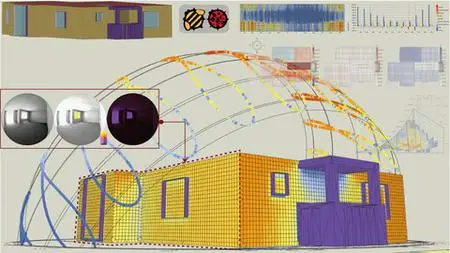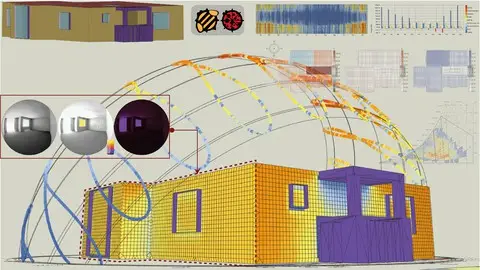Energy Simulations Using Ladybug Tools + Grasshopper
Last updated 10/2022
MP4 | Video: h264, 1280x720 | Audio: AAC, 44.1 KHz
Language: English | Size: 8.59 GB | Duration: 13h 45m
Last updated 10/2022
MP4 | Video: h264, 1280x720 | Audio: AAC, 44.1 KHz
Language: English | Size: 8.59 GB | Duration: 13h 45m
Learning how to use Ladybug and Honeybee from Tools for your residential designs
What you'll learn
Understanding of the logic and requirements of 3D modeling for environmental analysis and energy simulations.
Creation of hourly and monthly graphs of climatological data
Analysis of passive design strategies according to geographic location
Creation of studies of radiation, solar incidence and winds, and some applications in the envelope
Creation of energy models from scratch and analysis of results.
Understanding of the minimum requirements to generate occupancy schedules, equipment, lighting, hot water, HVAC.
Requirements
No experience using the software is required. You will learn everything you need to know.
You will use Rhinoceros 7.
In a video I will explain how to install the programs that you will use in the course
Preferably Windows as operating system or working with Parallels or Bootcamp
Description
Course objectiveGenerate your own climate and interactive graphs. Learn to generate solar, radiation and wind studies and apply some of these studies into the envelope. Create energy simulations in Honeybee Energy. You will learn the bases for energy modeling and thus be able to generate energy savings, decrease / increase interior temperatures, change of construction materials, occupation schedules, among others.ScopeThis course will provide you with the bases to carry out your energy simulations, to carry out these simulations using the Grasshopper program included in the Rhinoceros 3D software. You will use the LadybugTools tool: Ladybug, Honeybee, Honeybee Energy, and Honeybee Radiance.Note: YOU DO NOT NEED TO HAVE THE INSTALLED PROGRAM. During the first class we will review the installation of the program and the plugins. Even if you already have the software installed, we will check that it is installed correctly. A bad installation causes that it does not generate the energetic simulations.During this course I will take you by the hand so that from a 3D model of a house you can generate environmental analysis and create an energy model. Hene, step by step you will see how to build this model so that you can simulate scenarios and see the differences between both cases.This course has the peculiarity that it shows you how to customize your schedules and laodsfor people, equipment, lighting, hot water, construction materials, add new windows, generate shading on them (louvers or parasols), and much moreFurthermore, you will learn how to use Honeybee Radiance for building recipes ato perform indoor daylight analysis and thermal comfort maps.Welcome!
Overview
Section 1: Chapter 1: Software explanation
Lecture 1 Rhino Installation
Lecture 2 Software Installation (LadybugTools)
Lecture 3 Explanation
Lecture 4 Meters Template
Lecture 5 Legacy VS Tools
Section 2: Chapter 2: Preparing the envelope and rooms for the LadybugTools analysis
Lecture 6 Envelope creation
Lecture 7 Rooms creation
Section 3: Chapter 3: Ladybug from LadybugTools
Lecture 8 Reading and plotting weather data
Lecture 9 Psychrometric chart and Heating and Cooling Degree Days
Lecture 10 Studies: SunPath, WindRose, and Radiation Domes
Lecture 11 Direct Sun Hours, Incident Radiation, and View Percent applied into the envelope
Section 4: Chapter 4: Honeybee from LadybugTools
Lecture 12 Creating the Honeybee model from the rooms created in section 2
Lecture 13 Finishing the energy model and running the first energy model
Lecture 14 Customizing the model: Adding new windows and shadings
Lecture 15 Customizing the model: Modifying the hot water program
Lecture 16 Customizing the model: Modifying the people program
Lecture 17 Customizing the model: Modifying lighting, equipment, and inflitratrion program
Lecture 18 Customizing the model: Modifying the construction set and construction materials
Lecture 19 Customizing the model: Assigning ventilation, HVAC templates and airflow network
Section 5: Chapter 5: Honeybee Radiance Recipes
Lecture 20 Recipes
Section 6: Chapter 6: Honeybee Energy Results and Comfort Maps
Lecture 21 Room Energy Result, End Use Intesity, HVAC Sizing, and Thermal Load Balanace
Lecture 22 Thermal Comfort Models: Adaptive, PMV/PPD, and UTCI
Lecture 23 Solving a doubt about PMV thermal comfort map.
Lecture 24 Thermal Comfort Models applied into the Energy Model
Lecture 25 Create the lighting schedule based on the annual daylight recipe
Lecture 26 Perform custom simulation outputs
Section 7: Chapter 7: Answering classmates doubts
Lecture 27 Updating LB in Grasshopper environment and accessing the simulation report file
Professionals or passionate about architecture, energy engineering or related whose interest is to learn how to perform rigorous energy simulations.,Architecture, sustainable design and energy engineering students,Individuals interested in environmental analysis applied to the residential sector.



